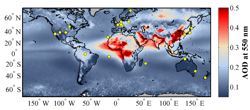ESA GHG-CCI Project
Aerosols have been identified as an important factor causing biases in satellite GHG products (e.g. Heymann et al., 2012). Aerosols can significantly modify the length of the light path and thereby alter the apparent absorption observed by the satellite. Reliable GHG retrievals can be made only when the aerosol loading is below some threshold. Hence, to obtain accurate XCO2 or XCH4 observations from a satellite requires that these highly scattering scenes are correctly identified and filtered out, and that the aerosol effects for the remaining scenes are properly accounted for in the retrieval.
In this project, Empa investigated how well the GHG CCI CO2 algorithms filter out the high scattering aerosol scenes and to which extent a possible bias in satellite XCO2 can be attributed to aerosols. A challenge in this work was, however, that most of the TCCON stations are located in areas where the aerosol loading and the corresponding influence on the retrieval are generally quite low (see Figure). On the other hand, TCCON provides the most accurate observations of the column-averaged dry-air mole fractions of CO2, and, therefore is the most useful validation data set.
We used aerosol observations obtained either from the global AERONET sunphotometer network (Holben et al., 1998), or from satellite instruments dedicated to observe aerosols. The advantage of using AERONET observations is that the sunphotometers provide very accurate observations of several aerosol optical properties including aerosol optical depth (AOD). On the other hand, there are only three locations where an AERONET and a TCCON station are located next to each other.
To be able to include also those TCCON stations in the analysis that don't have an AERONET station in their vicinity, GOSAT and SCIAMACHY XCO2 observations were additionally collocated with satellite-based aerosol data. Both AERONET and satellite-based aerosol data were used to analyze the quality of the filtering for highly scattering scenes as well as the dependence of biases of the satellite XCO2 observations (with respect to TCCON) on aerosol parameters. By using satellite-based aerosol data we were also able to carry out additional tests, e.g. to investigate how variable the aerosol conditions actually were in the surroundings of the TCCON stations.


